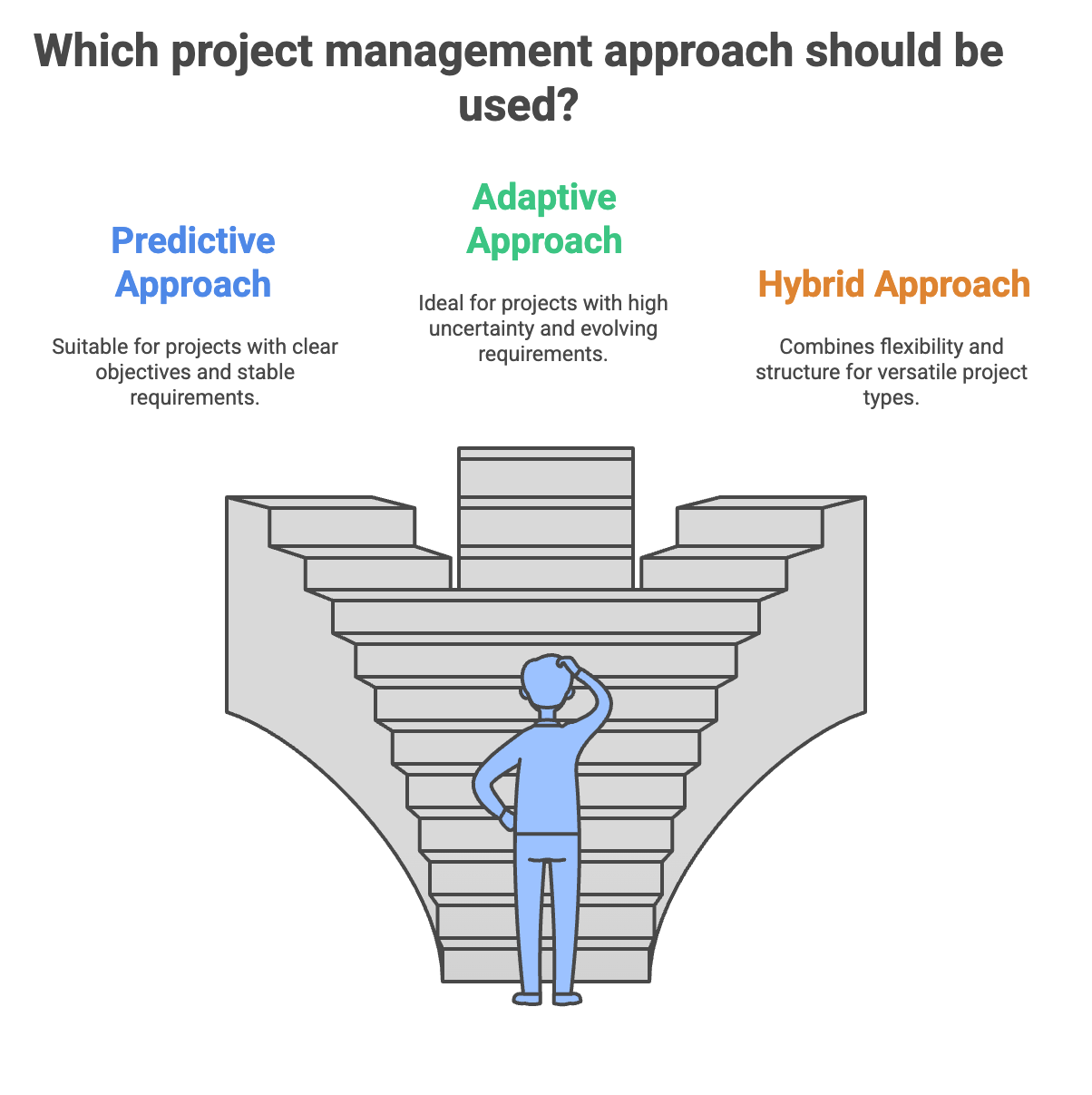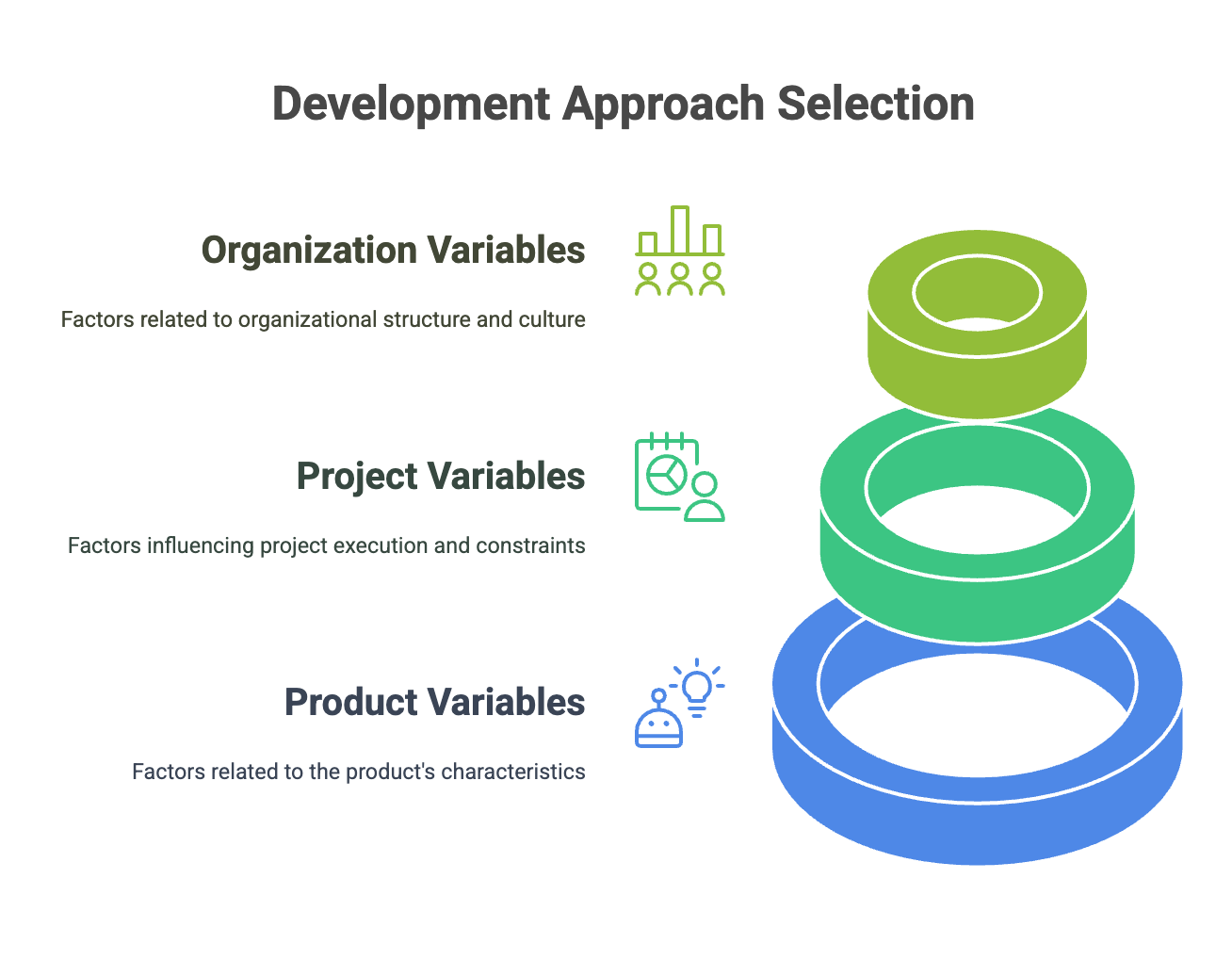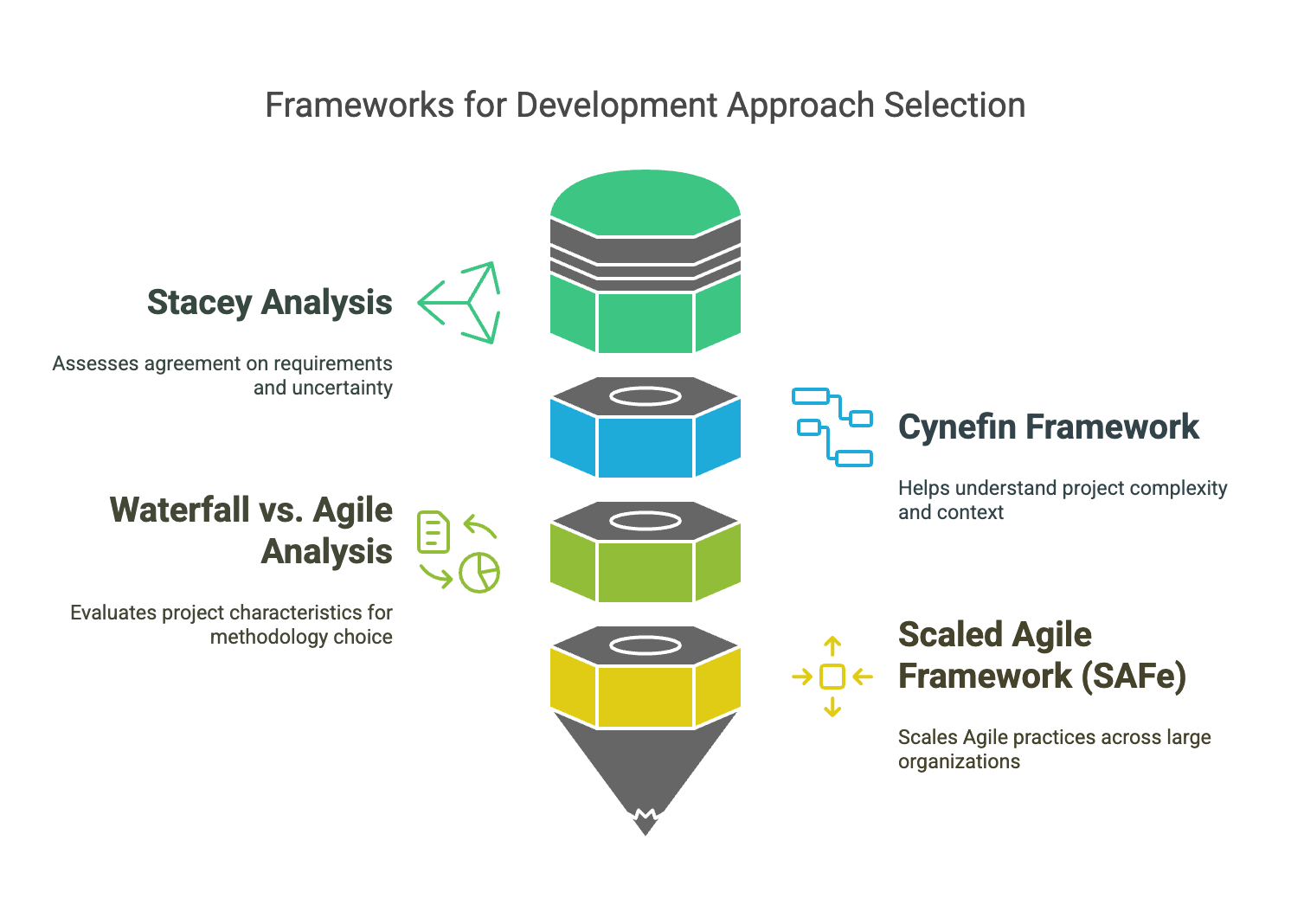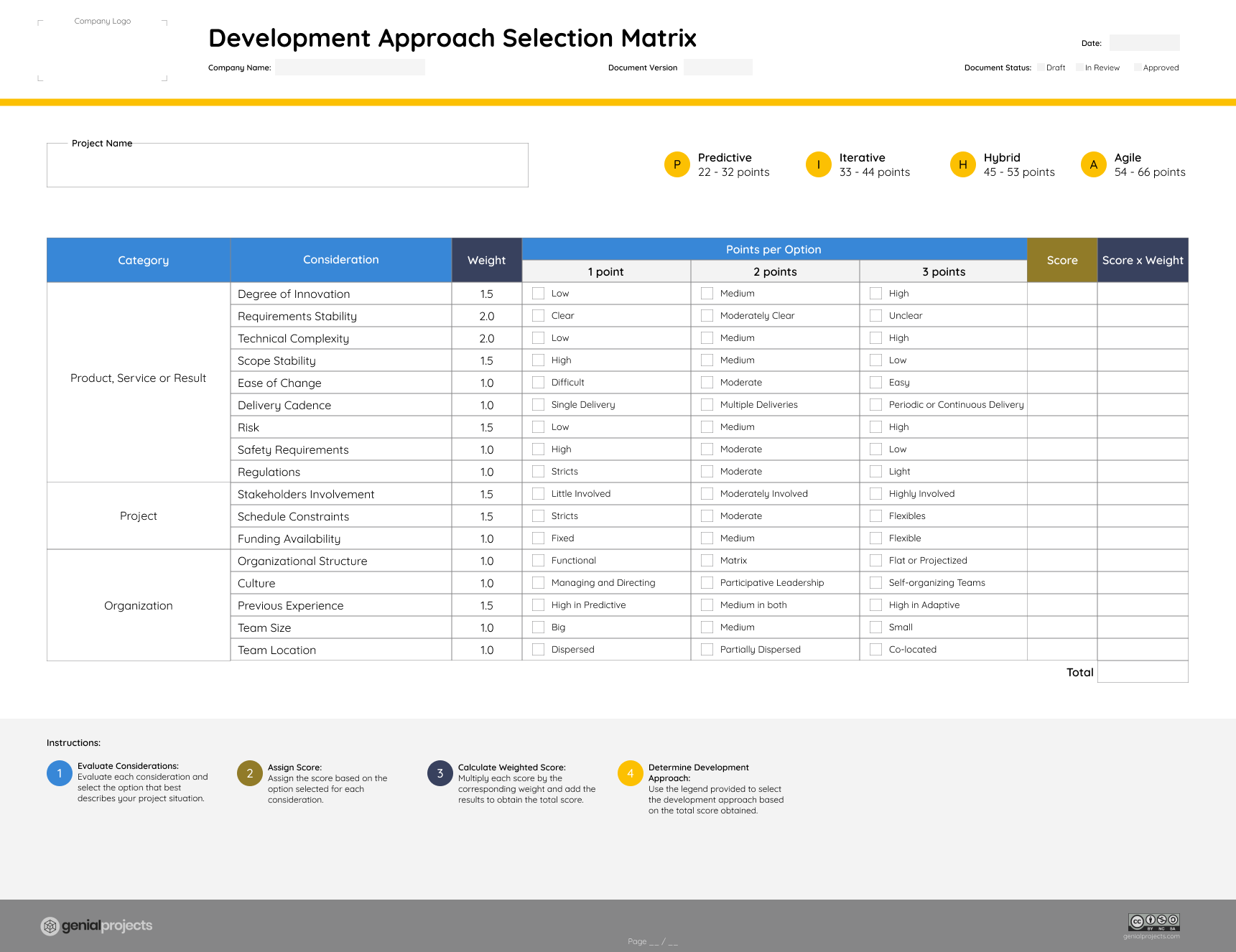Selecting the right development approach is a crucial step in project planning. The chosen approach affects everything from the cadence of deliveries to the overall project lifecycle. This article aims to provide a comprehensive guide on selecting the appropriate development approach using a selection matrix developed by Genialprojects, informed by the guidelines of the PMBOK 7th edition.
Understanding Development Approaches
What is a Development Approach?
The Project Management Institute defines a development approach as “A method used to create and evolve the product, service, or result during the project lifecycle, such as predictive, iterative, incremental, adaptive, or hybrid methods.” Basically, the development approach defines how project activities are structured and executed, impacting the project's outcomes, efficiency, and adaptability.
It is possible to adopt one or multiple development approaches during a project, depending on the project's characteristics, the products or results aimed for, the organization driving the project, and the industry in which it operates.
Types of Development Approaches
Selecting the right development approach for a project involves understanding the various types of methods available and their respective advantages. Each approach has unique characteristics and is suited to specific project conditions, phases, and requirements. We can classify the various methods available into the following categories:
- Predictive: Predictive approaches, often known as waterfall models, are characterized by their structured and sequential phases. They are suitable for projects with clear objectives, stable requirements, and low uncertainty.
- Adaptive: Adaptive approaches, including Agile approaches, are flexible and iterative. They accommodate changes and continuous feedback, making them ideal for projects with high uncertainty and evolving requirements.
- Hybrid: Hybrid approaches combine elements of both predictive and adaptive methodologies. They offer flexibility while maintaining some structured phases, making them versatile for various project types.

Importance of Selecting the Right Development Approach
Choosing the correct development approach is crucial because it determines the project's structure, delivery frequency, and adaptability to changes. This selection directly influences the project's success, especially in terms of meeting deadlines, staying within budget, and fulfilling stakeholder expectations. Predictive approaches are often employed when the project has a single deliverable at the end, while adaptive and hybrid approaches accommodate multiple or periodic deliverables. Consequently, the choice of development approach and delivery frequency impacts the project's lifecycle and its phases.
How to Choose a Development Approach
Selecting the right development approach requires careful consideration of various factors influencing the project's execution. These factors can be grouped into three main categories related to the product, service, or result expected; the project itself; and the organization. Understanding these considerations and how they interact is essential to make an informed decision that aligns with the project's goals and constraints.
Considerations for Selecting a Development Approach
The PMBOK Guide (2021) outlines the following variables to consider when selecting a development approach:
Product, Service, or Result:
- Degree of Innovation
- Requirements certainty
- Scope stability
- Ease of change
- Delivery options
- Risk
- Safety Requirements
- Regulations
Project:
- Stakeholders
- Schedule constraints
- Funding availability
Organization:
- Organizational Structure
- Culture
- Organizational capability
- Project team size and location

Existing Selection Models
Existing models like Stacey Analysis, which assess the level of agreement on requirements and the degree of uncertainty, provide a foundational framework for selecting a development approach. Other notable models include the Cynefin Framework, which helps in making sense of the complexity and context of a project to guide the decision on the appropriate management and development approach. Another model is the Waterfall vs. Agile Analysis, which evaluates project characteristics to decide between traditional Waterfall and Agile methodologies. The Scaled Agile Framework (SAFe) is also a popular model, especially for larger organizations seeking to scale Agile practices across multiple teams and departments.

It is important to note that these models are often tailored to the specific needs and contexts of each organization. At Genialprojects, we have developed a scoring model that can be employed by organizations as an additional tool to guide their decision-making process. This model is designed to complement other methods, allowing organizations to use it alongside their existing frameworks or adapt it to their unique circumstances.
Introducing Genialprojects Development Approach Selection Matrix
Purpose and Benefits
The Genialprojects Development Approach Selection Matrix is a systematic scoring model for choosing the appropriate development approach for a project. It helps ensure that the approach selected aligns with the considerations outlined in The PMBOK Guide (2021), and offers an alternative to complement existing decision models.
Key Elements
Our model groups considerations for choosing a development approach into three main categories: Product, Project, and Organization. The following outlines the considerations taken into account in each category with slight differences from those suggested by the PMBOK Guide (2021):
Category | Considerations |
Product, Project, and Organization |
|
Project |
|
Organization |
|
Each consideration is assigned a weight based on its importance, and options for each consideration are scored from 1 to 3. The total score is obtained by multiplying each consideration's weight by its selected score. Finally, the total score is used to choose the development approach according to a scale.
You can see our Development Approach Selection Matrix in the following picture and, of course, it’s available for download in different formats, so you can use it on your projects.

Free Development Approach Selection Matrix Template available on our website.
![]() Challenges
Challenges
While the matrix offers a structured approach, it cannot replace the project manager's experience and judgment. It should be used as a tool to guide decisions, not as a definitive answer. Every project and organization is unique, and what is provided is merely a tool that can and should be adapted as needed. Another challenge is that even after concluding on a type of development approach (e.g., Agile), there still remains the task of selecting the specific methodology within that approach (e.g., Scrum, Kanban, etc.). This additional layer of decision-making requires further consideration of the project's specific needs and the team's capabilities.
Key Takeaways
Selecting the right development approach is an essential task for planning and executing projects. The Genialprojects Development Approach Selection Matrix offers a systematic scoring model to evaluate and choose the best approach, considering various factors related to the product, project, and organization. By following a structured process, project managers can ensure their chosen methodology aligns with project goals and organizational capabilities.
It is important to note that this matrix is not intended to replace other models but to serve as an additional tool for enhancing decision-making. Organizations can and should adapt the matrix to fit their specific context and needs, ensuring its applicability and effectiveness in their unique environments.